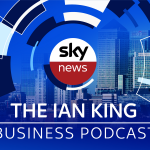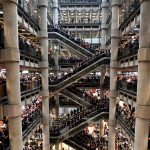Britain’s locked-down economy shrank by 1.5% in the first quarter of the year, official figures show.
The data covers a period when a resurgence in coronavirus cases resulted in renewed restrictions including school, retail and hospitality closures and “stay at home” advice.
But the impact on the economy appears to have been much smaller than during the first lockdown last year when gross domestic product (GDP) shrank by nearly a fifth over the April-June period.
Please use Chrome browser for a more accessible video player
Overall, 2020 saw GDP shrink by nearly 10%, the worst decline for three centuries.
But experts think the resilience of businesses throughout the latest lockdown, added to a strong bounce-back as restrictions ease for the remainder of the year, will result in 2021 seeing the strongest annual growth since the Second World War.
A month-by-month breakdown of the latest data from the Office for National Statistics (ONS) shows GDP shrank by 2.5% in January but grew again, by 0.7%, in February, and expanded by a better-than-expected 2.1% in March.
The ONS figures showed the economy was still 8.7% smaller than where it was at the end of 2019.
Britain’s tough start to the year has also been affected by a slump in trade with the EU following the end of the Brexit transition period, which resulted in additional red tape and costs.
The latest figures showed that exports to the continent had by the end of March recovered almost to December levels though imports from the bloc remained sluggish.
Chancellor Rishi Sunak said: “Despite a difficult start to this year, economic growth in March is a promising sign of things to come.
“Even with this positive news, we know that many businesses and people still need our help, and that’s why I want to reassure everyone today that our plan for jobs will continue to create, support and protect jobs in the coming months.”
Darren Morgan, ONS director of economic statistics, said: “The strong recovery seen in March, led by retail and the return of schools, was not enough to prevent the UK economy contracting over the first quarter as a whole, with the lockdown affecting much of the services sector.
“However, construction grew strongly over the quarter, and in March, was above its pre-pandemic level.
“Manufacturing also recovered from an initial fall, increasing strongly in February and March, as businesses continued to adapt and make themselves COVID-19 secure.”
Last week, the Bank of England revised up its forecasts for the UK economy, which it now expects to grow by 7.25% this year – the fastest pace since 1941.
Britain’s slump last year was the worst among all of the G7 group of major advanced economies.
Samuel Tombs, chief UK economist at Pantheon Macroeconomics, said the latest figures suggested it continued to lag behind other G7 nations when comparing how much they still lagged behind pre-COVID levels.
However, he said that as Britain “exhibited signs of life” in March and showed further momentum in April, a recovery in the second quarter should mean it “hands over the wooden spoon”.
Alpesh Paleja, lead economist at the CBI, said: “While latest data confirms the economy was hit once again by a renewed lockdown at the turn of the year, the fall in activity was much smaller compared with spring 2020.
“Households and businesses have clearly adapted better to working and living under COVID restrictions, despite the brutal cost of doing so.
“A range of indicators, including CBI business surveys, point to a rebound in activity heading into summer – with the economy opening up and pent-up demand waiting to be unleashed.
“But this is a recovery that will be felt more by some.
“Undoubtedly, hardest-hit sectors and households have a longer road ahead.”






















